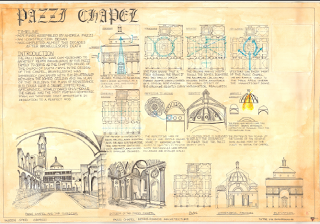History 1
The learning outcomes intended for the entire module involve:
The ability to recall appropriate architectural vocabulary when referring to building eras and types.
Illustrate,arrange and compare the sequence of historical periods and their architecture.
Differentiate the various factors that contribute to the progression of form.
To produce clear building analysis which exhibits intention,concepts,patterns,disciplines,architectural languages as well as contextual relationships.
Project 1
PRECEDENT STUDY
(Group)
We were required to conduct a study on specific buildings and produce an analysis report documenting our data.
The analysis report on the Pazzi Chapel,Florence ,Italy.(Italian Renaissance)
Project 2
Analysis Board
(Individual)
We were to produce drawing of the building studied,and to include all our data in the form of floor plans,sections, and elevations.The drawings were to demonstrate the depth of our analysis from the previous project.
Analysis Board
Reflections:
The board allowed me to demonstrate my architectural understanding of the building in terms of conceptual analysis,building massing analysis,circulation analysis,spatial organisation and building section analysis.It was a method for me to utilise to exhibit my knowledge on orthographic projections and to present my understanding of the historical period of Renaissance in Italy.
Project 3
Model
(Group)
Project 3 was model making,in which we were to create a model to communicate our analysis.The model was to be created from Balsa timber with 30cmx30cmx10cm dimensions.
Pazzi Chapel exterior view
Reflections:
Producing the model,took my analysis to the next level,ensuring an understanding of the materials and concepts used.Finally the presentation,allowed me to share my experience and knowledge of the building.








Comments
Post a Comment